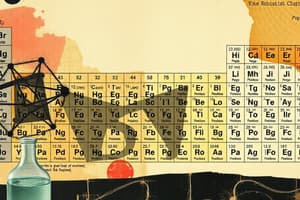Podcast
Questions and Answers
Quel est le but principal des questions de papier d'examen ?
Quel est le but principal des questions de papier d'examen ?
- Mesurer la capacité des étudiants à effectuer une analyse critique (correct)
- Aider à la compréhension des concepts fondamentaux
- Tester la mémoire des étudiants sur des faits
- Évaluer les compétences pratiques des étudiants
À quelle date les questions de papier d'examen mentionnées ont-elles été enregistrées ?
À quelle date les questions de papier d'examen mentionnées ont-elles été enregistrées ?
- 09 janvier 2025 (correct)
- 10 janvier 2025
- 08 janvier 2025
- 15 janvier 2025
Les pages de révision contenues dans le document concernent-elles un sujet spécifique ?
Les pages de révision contenues dans le document concernent-elles un sujet spécifique ?
- Non, elles sont générales et couvrent plusieurs matières (correct)
- Non, elles sont uniquement dédiées à l'histoire
- Oui, elles se concentrent sur la langue française
- Oui, elles se concentrent sur des sujets mathématiques
Quelle action est la plus appropriée pour les étudiants avant un examen ?
Quelle action est la plus appropriée pour les étudiants avant un examen ?
Quel est un effet potentiel de ne pas réviser adéquatement avant un examen ?
Quel est un effet potentiel de ne pas réviser adéquatement avant un examen ?
Flashcards
Fiches de révision
Fiches de révision
La création de fiches de révision est une technique d’étude efficace pour préparer les examens.
Révision espacée
Révision espacée
C’est une technique d’étude qui implique la révision du matériel d’étude à intervalles réguliers, augmentant progressivement la durée des intervalles.
Questions d’examen antérieures
Questions d’examen antérieures
La pratique des questions d’examen antérieures est un moyen important de se préparer aux examens.
Pages de révision
Pages de révision
Signup and view all the flashcards
Préparer les examens
Préparer les examens
Signup and view all the flashcards
Study Notes
Past Paper Questions on the Periodic Table
-
Q5 (a): The periodic table can be used to answer questions about the development of the periodic table.
-
Q5(a)(i): One piece of evidence supporting Newlands' ideas is the repeating pattern of elements with similar properties every eighth element in the modern periodic table.
-
Q5(a)(ii): Two reasons why many chemists in 1866 didn't accept Newlands' ideas are: Newlands' table didn't accurately predict the behavior of undiscovered elements and the placement of some elements (such as iron) didn't fit the periodic patterns.
-
Q5(b): Chlorine, bromine and iodine are in Group 7. A student investigated the reactivity of these elements with various compounds.
-
Q5(b)(i): Reactivity trend for Group 7: Their reactivity decreases down the group. Chlorine is more reactive than bromine and bromine is more reactive than iodine. This is related to the increasing size of the atom down the group, which weakens the attraction to bonding pair of electrons.
-
Q5(b)(ii): The balanced equation for the reaction between chlorine and potassium bromide is: Cl₂ + 2KBr → 2KCl + Br₂.
-
Q6: The question focuses on John Newlands' early periodic table and the organization of elements.
-
Q6(a): Iron (Fe) doesn't fit the pattern in column 7 because its properties don't completely align with the adjacent elements.
-
Q6(b): The question describes how Mendeleev arranged the elements in periods and groups based on their weight.
-
Q6(c): Lithium, sodium and potassium are in Group 1 due to similar electronic structures, specifically, one electron in their outer shells.
-
Q7: The question deals with the halogens (Group 7) and their properties.
-
Q7(a): Boiling points of halogens increase down the group from fluorine to iodine.
-
Q7(b)(i): The symbols for ions in sodium bromide are Na⁺ and Br⁻
-
Q7(b)(ii): Chlorine reacts with sodium bromide solution to produce bromine and sodium chloride: Cl₂ + 2NaBr → 2NaCl + Br₂.
-
Q8: This question is about atomic structure and elements.
-
Q8(a)(i): The atomic number of an atom is the number of protons.
-
Q8(a)(ii): The mass number of an atom is the sum of protons and neutrons.
-
Q8(b): An atom has no overall charge because the positive charge of the protons is equal to the negative charge of the electrons
-
Q8(c): Fluorine and chlorine are in the same group due to having the same number of electrons in their outer shell.
-
Q8(iv): Suggesting which halogen could react with sodium chloride to produce chlorine is contingent on knowing the reactivity series and electron configurations.
Studying That Suits You
Use AI to generate personalized quizzes and flashcards to suit your learning preferences.




